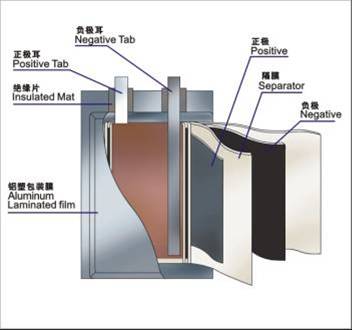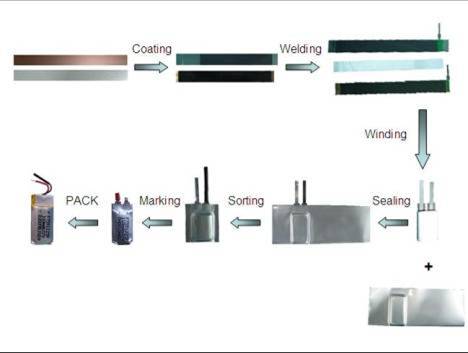Battery Knowledge
Polymer lithium ionbattery’s anode material is lithium cobalt dioxide and the cathode is carbon.Its outside package is Aluminum laminated film. It is known to all that thepolymer lithium ion batteries are the latest and secondary ones.
Polymer lithiumion battery’s configuration

Recharging and discharging processes

The polymer lithium ion battery’s produce ofprocess

The polymer lithium ion battery’sfeatures
A. High energy density
The special energy of polymer lithium ion battery can reach 380~400Wh/L.
B. High voltage
A single lithium ion cell has a voltageof3.7V ( mean value).
C. Pollution-free
Lithium ion battery does not contain any pollutingsubstances such as cadmium, lead, mercury… and others.
D. Non-metallithium
The lithium ion battery does not employany lithium metal. It is not governed by aircraft transportation rules relating to carrying lithium batteries inpassenger airplanes.
E. Longcycle life
Under normal conditions, the lithium ion batteryhas a life of more than 500 charge/discharge cycles.
F. No memoryeffect
Lithium ion battery is free from the so-called memory effect, aphenomenon seen in nickel-cadmium in which the apparent battery capacitydecreases when shallow charge and discharge cycles are repeated.
G. Fastcharge capacity
The lithium ion battery can be fullycharged in 1 to 2 hours, using a constant-current / constant-voltage (CC/CV) typededicated charger with a rated voltage of 4.2V per cell
The instructions of assembly work
3.1 the connection process:
We advise usingultra-wave jointing or dot jointing techniques to connect cell and PCM. If youwould like to adopt manual welding, please pay attention to the followinginstructions to protect the functions of cells:
a. The temperature of electric iron could be controlled and all theprocess should have static protection.
b. The temperature of electric iron should be less than350°C.
c. The welding time would be controlled in 3 seconds each time, and thetotal times of welding can’t be over 2 times.
d.If secondary welding is needed, please notice it should be done after cooling
e. Making welding operation directly on the topsides of cells isforbidden, the distance of jointing place and tab plastic must be more than2.0mm.If the temperature of sides is about orover60℃,the sealed strength will decrease and then cause leakage.
f.Don’t heat cells directly; they will be damaged if the temperature is more than100℃.
3.2 Cell’s fixing
Make sure the cells can’t move in shells after fixing.
Thoroughly read theuser’s manual before use, inaccurate handling of lithium ion rechargeable Cellmay cause leakage, heat, smoke, an explosion, or fire. When not using Cell foran extended period, remove it from the equipment and store in a place withproper low humidity and low temperature
Frequently Asked Questions and Answers: (FAQ)
1. What arethe advantages of the polymer lithium ion battery?
A. The voltage of single battery can reach 3.6~3.8V
B. Large energy density
C. The long cycle life. The cycle life of polymer lithium ion batterycan reach 500 cycles usually.
D. Good safety, no pollution, no memory effect, no hazardous elements
E. Low self-discharge
2. What isthe capacity of the lithium ion battery?
The battery’s capacity includes Rated capacity and Actual capacity.Rated capacity is the minimum capacity at the certain discharge condition.Actual capacity is the capacity when discharge at the certain condition whichis mainly affected by temperature and discharge current.
3. What’s the resistance of the polymer lithiumion battery?
It is the resistance when the electricity passes the battery. The bigresistance can reduce the discharge voltage and short the discharge time. It isdetermined by the material, produce process, battery structure and so on. Theresistance is an important parameter to evaluate the battery performance. Theresistance should be tested by the special equipment but not multi-meter.
4. What isthe self-discharge rate?
It is also called the capacity keeping ability. It means that theability of keeping the capacity under the certain condition during opencircuit. It is mainly affected by produce process, materials, storageconditions etc. Self-discharge rate is an important parameter to evaluate thebattery performance
5. What isthe battery’s working voltage?
It is also called the outside voltage. It is the voltage differencebetween the anode and cathode of working battery. The polymer lithium ionbattery’s working voltage is about 3.7V
6. What caused the battery’s swelling and leakage?
Because of theover-charge, short-circuit, self-discharge etc, the battery’s inner structurecan be changed greatly, and then it can cause battery swelling. The batteryleakage is caused by mistake or Aluminum laminated film damaged


